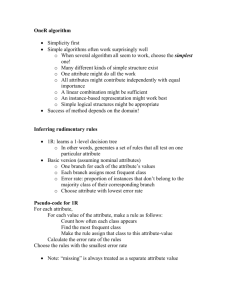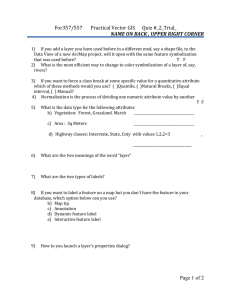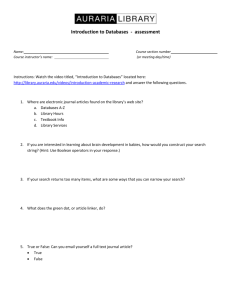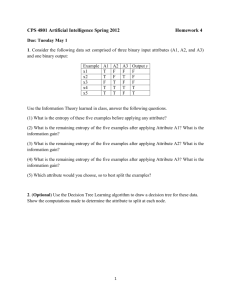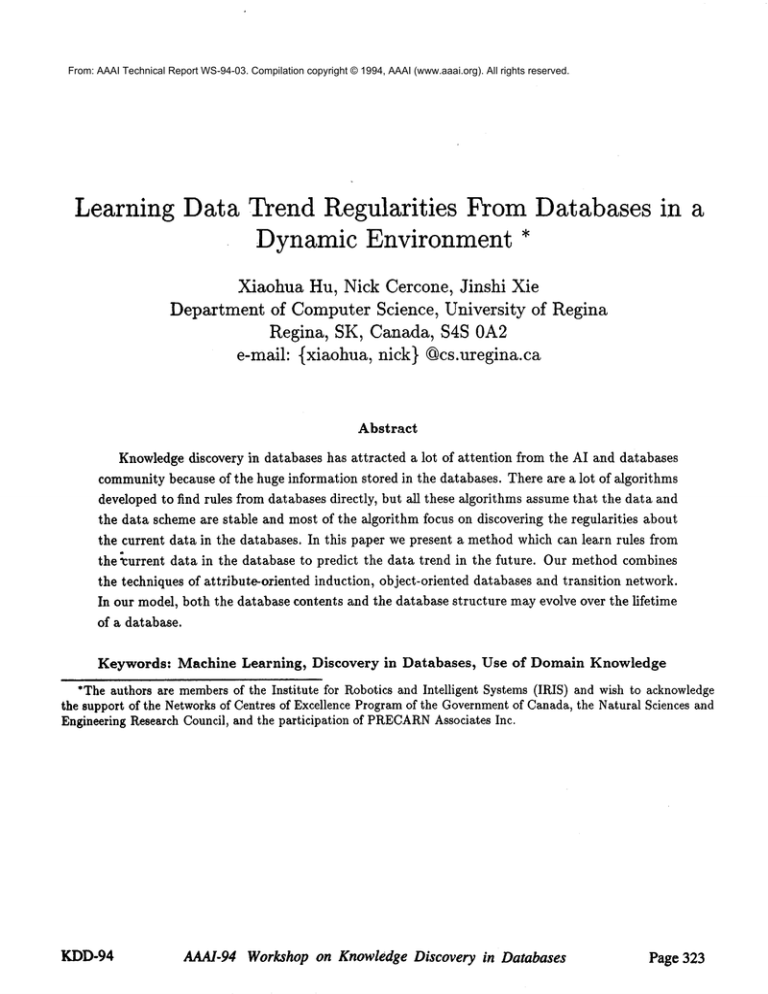
From: AAAI Technical Report WS-94-03. Compilation copyright © 1994, AAAI (www.aaai.org). All rights reserved.
Learning Data Trend Regularities From Databases in
Dynamic Environment *
a
Xiaohua Hu, Nick Cercone, Jinshi Xie
Department of ComputerScience, University of Regina
Regina, SK, Canada, $4S 0A2
e-mail: {xiaohua, nick} @cs.uregina.ca
Abstract
Knowledgediscovery in databases has attracted a lot of attention from the AI and databases
communitybecause of the huge information stored in the databases. There are a lot of algorithms
developed to find rules from databases directly, but all these algorithms assume that the data and
the data schemeare stable and most of the algorithm focus on discovering the regularities about
the current data in the databases. In this paper we present a method which can learn rules from
the :current data in the database to predict the data trend in the future. Our method combines
the techniques of attribute-oriented induction, object-oriented databases and transition network.
In our model, both the database contents and the database structure mayevolve over the lifetime
of a database.
Keywords: Machine Learning,
Discovery
in Databases,
Use of Domain Knowledge
*The authors are membersof the Institute for Robotics and Intelligent Systems (IRIS) and wish to acknowledge
the support of the Networksof Centres of Excellence Programof the Governmentof Canada, the Natural Sciences and
EngineeringResearch Council, and the participation of PRECARN
Associates Inc.
KDD-94
AAAI-94 Workshop on Knowledge Discovery
in Databases
Page 323
1
Introduction
Knowledgediscovery in databases has attracted a lot of attention from the AI and databases
communitybecause of the huge information stored in the databases. There are a lot of algorithms
developed to find rules from databases directly [3], but all these algorithms assume that the data
and the data scheme are stable and most of the algorithms focus on discovering the regularities
about the current data in the databases. The reality is that the contents of databases and database
schememay change over time and users are often interested in finding the general trends of data
evolution in the future. So it is important to discover data evolution regularities in a dynamic
evolving database. Because of the large volume of data, data evolution regularity can not be
simply expressed by enumeration of the actual data. Machine learning technology should be
adopted to extract such regularities in databases.
In this paper we propose a new method for discovering rule from the current data in the
databases to predict the data trend in the future. Our method combines the techniques of
attribute-oriented induction [2], object-oriented databases and transition network. In our model,
both the database contents and database structure (schemes) may evolve over the lifetime of
database.
This paper is organized as follow: In section 2 we discuss the primitives for learning data
trend regularities. The principle and algorithms for learning in dynamicenvironment is presented
in Section 3. The study is summarizedin Section 4.
2
Primitives
for Learning Data Trend Regularities
The real world is a dynamic and evolving place, to represent and simulate it efficiently and
effectively, we use the object-oriented data model because object oriented representations are
very convenient to describe real world. Our method involves elements of the following areas:
attribute-oriented
induction, object-oriented database model and transition network. In this
section, previous work from each of these areas is reviewed.
2.1 Attribute-Oriented
The attribute-oriented
Induction
induction was first proposed in [2]. The key to the approach is an attribute-
oriented concept tree ascension technique for generalization which was implemented using welldeveloped set-oriented database operations, substantially reducing the computational complexity
of the database learning task. An attribute is generalizable if there are a large numberof distinct
values in the relation but there exists a concept hierarchy for the attribute ( i.e., there are higher
level concepts which subsumethese attribute values). Otherwise, it is nongeneralizable.
Page 324
AAAI-94 Workshop on Knowledge Discovery
in Databases
KDD-94
The general idea of basic attribute-oriented induction is one in which generalization is performed attribute by attribute using attribute removal and concept tree ascension. If an attribute
is nongeneralizable, then it should be removed in the generalization. Attribute removal corresponds to the generalization rule, dropping conditions [5]. Consider a tuple as a set of conjuncts
in the logical forms; an attribute value together with its attribute nameform one of the conjuncts.
By removing a conjunct, a constraint is eliminated and the concept is generalized. If there are a
large set of distinct values for an attribute, the large set of values must be generalized. However,
if there is no higher level concept provided for the attribute , it can not be further generalized
by ascending the concept tree. Therefore, the attribute should be eliminated in generalization.
Attribute removal can also be viewed as a generalization
concept ANYand then removed from the representation.
of the attribute
to the most general
If an attribute is generalizable, then it should be generalized to a higher level concept value by
concept tree ascension techniques. Concept tree ascension corresponds to the generalization rule,
climbing generalization trees [5]. If there exists a higher level concept for the value in the concept
tree, then the substitution of the value in each tuple in the relation by the corresponding higher
level concept makes the tuple cover more cases than the original one, and thus it generalizes the
tuple.
As a result, different tuples maybe generalized to identical ones, and the number of distinct
tuples in the generalized relation is reduced. In the procedure of generalization, the tuples in
database are generalized to the desirable level, the table gained at this stage is called generalized
relation. The generalized relation contains all the essential information of the original data in the
database.
2.2
Object-Oriented
Model
Object-oriented data models and systems embodyrich data structures and semantics in the construction of complex databases, such as complex data objects, class/subclass hierarchy, property
inheritance, methods and active data etc.
An OODB
organize a large set of complex data objects into classes which are in turn organized
into class/subclass hierarchies with rich data semantics. Each object in a class is associated with
(1) an object identifier, (2) a set of attributes which maycontain sophisticated data structures,
or list-valued data, class composition hierarchies, multimedia data etc., and (3) a set of methods
which specify the computational routines or rules associated with the object class.
Objects & Object identifies:
Objects can serve to group data that pertain to one-world
entity. For example, we can treat a document as an object which group chapters, indexes, etc.
into one entity, namely, a document. Chapters serve as attributes of the documentobject. In like
manner, a chapter can be defined as another type of object which groups sections into one entity.
The uniform treatment of any real-world entity as an object simplifies the user’s view of the real
KDD-94
AAAI-94 Workshop on Knowledge Discovery
in Databases
Page 325
world. This implies that the state of an object consists of values for the attributes of the objects,
possibly with their own.
Objects can have a unique identity
independent of the values that they contain. A system
that is identity-based allows an object to be referenced via a unique internally generated number,
an object identifier, independent of the value of its primary key, if any. The adoption of object
identifier facilitates the representation of the state of an object, namely, the state of an object is
naturally represented as a set of identifiers of the objects which are the values of the attributes
of the object
Complex Attributes g~ Methods: In an object-oriented
database, object attributes
may
be complex attributes: references, collection and procedures. Reference attributes are analogous
to pointers in programminglanguage, or to foreign keys in a relation system. Collection is used for
lists, or arrays of values. The collection mayinclude simple attribute values and also references.
Derived attributes are those whosevalues can be defined procedurally rather than stored explicitly,
by specifying a procedure to be executed whenthe value is retrieved or assigned. For example, we
may store such personal information as birth date and age in a personal databases. The birth date
will not change but the age will. It would be desirable to define a procedure for the age attribute
so that it always represents the difference between the current date and the birth date. Derived
date correspond roughly to views in the relational database, but procedure languages maydefine
more complexderivations than views, and are generally used to define individual attributes rather
than relation. Since knowledge discovery in database is a read-only operation to the database
and:does not change the state of the database in any way, derived attribute values, once retrieved
from the database can be treated just like regular attribute values. Derived attributes do not
pose any special problem to the knowledge discovery process.
Method is another important component of OODBs.Many behavior data of objects can
be derived by application of methods. Since a method is usually defined by a computational
procedure/function or by a set of deduction rules, it is difficult to perform generalization on
the method itself unless the generalization of the method is clearly understood by application
programmers and is coded as a new method which directly performs the required generalization.
In general, the generalization on the data derived by method application should be performed in
two steps : (1) deriving the task-relevant set of data by application of the methodand, possibly,
also data retrieval; and (2) performing generalization by treating the derived data as the existing
ones.
Class: Class is used to group together object that respond to the same message, use the same
methods, and have variable of the same nameand type. Each such object is called an instance of
its class. A class defines an object type or intent-the structure of a particular type. The intent
includes structure (that is, the attributes and relationships in which objects having this type can
participate) and behavior (that is , the methods associated with the type).
Page 326
AAAI-94 Workshop on Knowledge Discovery
in Databases
KDD-94
2.3
Transition
network
Object-oriented model is supposed to model the real world more closely than traditional relational
data model because each real world entity can be modeled by an object in the computer. Unfortunately, while the real world is a dynamic and evolving place, most object-oriented data models
are essential static: although objects can be dynamically created and destroyed, class can not.
They either do not support, or do not conveniently support, structural and behavioral changes
to instantiated objects. Databases, including object-oriented databases, often allow historical
accesses, but only for objects whose structure does not change. Noneof these systems provides
the mechanismnecessary to describe data relation across transition in a dynamicsystem [1]. Further, classes can not be dynamically modified as further attributes and behaviors of the objects
are discovered or needed. One of the key issues when combining a dynamic object-oriented data
model with time and histories to produce a dynamic system is how the relationships between the
instance variables in different state are defined. In our method, we use transition con.straints to
model the relationship between the instances variables in different state.
Wesay that an object which is an instance of one class (called the source class) undergoes
transition whenit becomesan instance of another class (called target class). Wedistinguish two
types of transition evolution and extension [4], based on whether or not the object undergoing
the transition is preserved as an instance of the source class or not. In other words, an evolution
occurs when the transition object ceases to be an instance of the source class. For example,
whenan object representing an applicant changes to reflect the acceptance of the applicant, it
undergoes an evolution; that is, it ceases to be an instance of the applicant subclass and becomes
an instance of the student subclass. An extension is a transition with the negative of the additional
condition associated with evolution. In other words, an extension occurs whenthe object remains
an instance of the source class with the negation of the additional condition associated with
evolution. For example, when an alumnus with a Master’s degree applies to the Ph.D program,
the transition of the object representing the alumnus into an instance subclass is an extension.
Note that someof the transition events are triggered solely by time whereas others are triggered
by other events in the dynamic system. In this paper we assume only evolution occurs in our
dynamic environment model.
2.4
An Example
Database
Consider a simple version of the social security database in somesocial benefit office in Canadaas
shownin Table 1,2,3. Figure 1 is the concept hierarchies for attributes age, salary and pension.
Figure 2 is the corresponding class hierarchy and transition network. Citizen maystart as a child.
Whenchildren reach the age of 18, they become the instance of Adult class. Later, at age 65,
they retire (senior citizen) and eventually die. The transition from senior citizen to death is weak
KDD-94
AAAI-94 Workshop on Knowledge Discovery
in Databases
Page 327
old
al
a2
a3
a4
name
Sam
Janet
Mary
Tom
sex
M
F
F
M
birthday
Dec. 5, 1954
Aug. 4, 1988
June 23, 1945
July 17, 1963
age
method(birthday,
method(birthday,
method(birthday,
method(birthday,
am
Jay
Mark
M
M
Oct. 24, 1970
Jan. 29, 1940
method(birthday, today)
method(birthday, today)
today)
today)
today)
today)
employer
NCR
BNB.
NT
GOV.
salary
7Ok
53k
60k
36k
dependents
(c1,c2,c3}
(¢4, ¢5}
(¢6)
o
MPE
NGE
40k
lOOk
(ci)
(cj,ck}
Table 1: Instance of Class Adult
old
cl
c2
c3
c4
name
Jane
Janet
Mary
Peter
sex
F
F
F
M
birthday
Oct. 5, 1984
June. 4, 1986
June 23, 1985
July 17, 1979
age
method(birthday,
method(birthday,
method(birthday,
method(birthday,
cx
cz
John
Frank
M
M
Feb 24, 1980
Jan. 29, 1982
method(birthday, today)
method(birthday, today)
today)
today)
today)
today)
parent/guardian
al
al
al
a2
school
No, 1
No.1
No. 2
Bran
az
a2
MMM
PCC
Table 2: Instance of Class Child
because some people maylive older than 85 while some other maynot. Weuse / > to represent
weaktransition. For brevity, we still list databaseobjects in tables similar to howwe list tuples
in a relational table; the differences are, in addition to showingall the attribute-value pairs, we
also showthe object identities (oids) and the values for reference attributes are oids. Fromthe
knolyledge discovery point of view, it is unnecessaryto distinguish which data are stored within
the class and which are inherited from its superclass. As long as the set of relevant data are
collected by query processing, the KDDwill treat the inherited data in the same wayas the data
stored in the object class and performgeneralization accordingly.
{0-4}: kids; {4-14}: children; {14-:20): young
(20-29}: twenties; {30-39): thirties; {40-49}: forties
(50-64}: late_mid; (65-}: old
(kids, children}: child_age; {young, twenties}: young_age
(thirties, forties, late_mid}: mid_age;{ old}: old_age
{child_age, youth_age, mid_age, old_age}: Any(age)
{()-20k}: low_income; {20K-34k): low_middleAncome;{35k-45k): mid_income
{46-65k}: high_income; (66k-}:very.highlncome;
{low.income, low_mid_income, mid_income, highAncome,very_high_income}: Any(income)
Figure 1: The concept hierarchy for age, salary, pension
Page 328
AAAI-94 Workshop on Knowledge Discovery
in Databases
KDD-94
old
sl
s2
s3
name
Woope
Jason
Rote
SeX
F
M
F
birthday
Oct. 5, 1925
July 14, 1929
Jan. 28, 1913
age
method(birthday, today)
method(birthday, today)
method(birthday, today)
pension
17k
23k
60k
sl
sk
Codoba
Clark
M
M
Aug.,24, 1910
Feb, 23, 1914
method(birthday, today)
method(birthday, today)
40k
10k
Table 3: Instance of Class Senior citizen
I
n~e
Person [birthday,
/ age=18p
Child
age=65
Adult
[
age
I
,~
age~85
SeniorCitizen
@
parent/guardian
[
emplOyerl
] salary
dependents
school
SeniorCitizen.pension=Adult.salary
[pension[
when retired * 65%
Child.name=Adult.Name=SeniorCitizen.n~e
Figure 2: The class hierarchy and transition networkfor people
3
Principle
and Algorithms for Learning in
Dynamic
Environment
3.1 General Discussion
The general trend of evolution describes howa particular set of data evolves over a period of time,
for example, how the population changed over the past 10 years, or what is the trend 5 years
later. To discover data evolution regularities in the future, the evolving data should be identified
first and be extracted from the database.
In a relational database, we start learning by collecting relevant data into a relational table
using selection, projection, or join operations provided by the query language; namely, we makea
copy of the data portion in the database that are relevant to our learning task and the database
remains intact. We should abide by the same principle in an OODB.However, in an OODB,
instances are groupedinto classes and related objects of different classes are connected through
references, i.e., oids, whichacts as a counterpartof join in the relational sense. Attribute projection maynot be supported in an 00DBin a dynamic environment. Moreover since in a dynamic
KDD-94
AAAI-94 Workshop on Knowledge Discovery
in Databases
Page 329
oid
sl
s2
s3
name
Woope
Jason
Rose
sex
F
M
F
penslon
17k
23k
60k
sl
sk
Codoba
Clark
M
M
40k
lOk
Table 4: Instance
of Class Senior citizen
environment the data contents and scheme may change over the time, the data extraction procedure is more complicated. For example, if the city administrator wants to know the general
situation about the senior citizen 5 years later, the query maybe submitted as below:
learndata evolution trend for seniorcitizen
5 years later
in relevant to S.name, S.sex, S.pension
S
The data extraction procedure is performed in two steps (1) based on the query, extract the
target class objects; (2) examine the class hierarchy and transition network to check whether
there are any source class objects which can transform to the current learning class as time goes
by. For the above query, the first step is to extract all the citizens from the current senior citizen
class except those whoare 80 years old (because we assume that senior citizen die at 85). Then
we $xaminethe class hierarchy and transition network and find an Adult becomes a senior citizen
when he reaches 65. Hence we have to look through the Adult object class and extract those
adults who are older than 60 and derive the corresponding attributes values, e.g. replace salary
by pension. (we can assume that adult salary increases 4% each year, first compute the adult
salary when he retires , and then apply the method: seniorcitizen.pension=adult
salary when
retired * 65 %). As a result, we get a set of task-relevant instances objects as shownin Table 4.
The "relevant data " returned from a query into an OODB
is generally a set of oids pointing
to instances of a specific class-the queried class. After obtaining object instance relevant to
our learning task, we maystart the induction process. The basic strategies of attribute-oriented
inductions [2] are still applicable whenthe induction is conducted on an attribute whosevalues are
of a primitive class. For example, in the generalization process, the attribute "S.name" is removed
( even if it were in relevance to the learning query) since it has no superordinate concept. Since
attribute projection may not be supported in an OODB,we encounter some technical differences
here from in a relational databases. Relevant as well as irrelevant attributes of objects of this
class can be accessed by dereferencing the oids in this set; attributes of related objects of other
classes are accessed through reference attributes.
One of the essential components of an OODB
is object identifier (oid) which uniquely identifies objects. It remains unchanged over structural reorganization of data. Since objects in an
Page 330
AAAI-94 Workshop on Knowledge Discovery
in Databases
KDD-94
OODB
are organized into classes which in turn belong to certain class and subclass hierarchy,
the generalization of objects mayrefer to their corresponding class and subclass hierarchy. In the
object-oriented database model, no two object instances are equal even if they have the identical
values for each of their attributes, because their oids will never be the same. The relational
attribute-oriented
induction method is value-based. In an object-oriented database, when we
judge whether two object instance are "mergeable" in the relation sense, we only compare values
in the relevant attributes, ignoring the oids. Whenchecking whether two reference attributes
have equal values, we see if the composing attributes of the pointed object instances are equal
instead of comparing the oid values of the two reference attributes. Irrelevant attribute values
are not compared. If two instances have identical values for every task-relevant attributes, one of
them is considered redundant even though their oids are different. To "merge" two instances, we
simply delete the old of one of them from the class extent and record the number of redundant
object in vote.
The evolving data mayhave two kinds of attributes:
stable attributes
and evolving attributes.
The stable attributes, in which the data values do not change over time, can be generalized by
attribute-oriented induction in the same way as those discussed in [2]. The evolving attributes, in
which the data. values change over time, can be generalized according to a generalized time slots
when appropriate. For example, adult’s salary keeps changing yearly and so we need to update
the salary based on the time value. Once we get the value for the salary, then we can still
attribute-oriented induction.
apply
As to generalization of collection attributes and reference attributes, these two categories of
complex attributes maybemixed. A collection attribute can have elements of pointers to another
class; a reference attribute can point to class consisting of collection attributes. Generalization of
a collection attribute should be performed on its composing elements and the generalized concept
for the collection is expressed in terms of its generalized elements. Generalization on a reference
attribute is conducted on each composingattribute of the object class being pointed to. Since the
objects being pointed to maybe of a class that contains reference attribute as well, we may have
to apply the strategy of collection attribute several times. By the least commitmentprinciple
[2], generalization should start on the finest concepts in order to guarantee correctness. This
means we may have to keep on dereferencing pointers until we reach a non-reference attribute.
The class composition hierarchy contains the information that will guide this pointer dereference.
Whenthere exists a link from an attribute in one class to another class, and whenthis attribute
is relevant to the learning task, this link (pointer) should be dereferenced, that is, generalization
moves on to the referenced class. No more dereferencing is needed when we have come down to
a leaf class in a class composition hierarchy.
As a result of generalization, different objects may be generalized to equivalent ones where
two (generalized) objects are equivalent if they have the same corresponding attribute values
without considering their object identifiers and a special internal attribute count, which register
KDD-94
AAAI-94 Workshopon KnowledgeDiscoveryin Databases
Page 331
,, oid
gl
g2
g3
g4
g5
ge
g7
~s
sex
F
M
F
M
F
M
M
M
pension
low.income
Iow.lncome
low.mid .income
iow-mid.inc0me
mid-lncome
mid.lncome
high-income
very.high.lncome
total
count
30000
25000
10000
15000
5000
I0000
3000
2000
I00000
Table 5: Instance of Class Senior citizen
the numberof objects in the initial workingclass. Notice that a generalized object, thoughhas its
ownnewoid (object identifier) in an OODB,
is a carrier of the general properties of a set of initial
objects because the original identifier has been generalized into a class or superclass name.The
count accumulatedin the generalized class incorporates quantitative information in the learning
process. After the generalization process, we get a generalized table as shownin Table 5.
Basedon this generalized table, we can derive someuseful data trend information: for example,
5 years later, there are about 100,000 senior citizens, 55~ are male, and 45 ~ are .female. Among
the female senor citizens,
3.2
66.7 ~ have lower income and so on
Algorithm
In s~mmary,we present the algorithm below. After task-relevant instances have been selected,
the procedure OOinductionis called. This procedure processes each attribute such that the
attribute threshold is satisfied. It then goes on to ensure that the final learned result contains no
more instances than the threshold. For each relevant attribute can be simple as of a primitive
class, or complexas of a set, a list, an array, or a reference, OOinductionhas to treat each
attribute according to its type; this is done by the subprocedure Resolve(A). The element
a collection attributes can again be a complexclass, and the attributes of the class pointed to
by a reference attribute mayalso be of a complex class. This gives Resolve(A) a recursive
nature. Since complex attributes are defined using primitive classes and can always break down
to primitive classes, Resolve(A) is guaranteed to terminate. Moreover,since all the extension
we madestrictly follow the least commitment
principle [2], the correctness of our algorithmis also
guaranteed. (In the algorithm "*A"refers to the object class pointed to by ’A’.)
Algorithm
1 An Data Trend Discovery
Algorithm
Input: (1) an object-oriented databases (2) a set of class hierarchies and transition network,
a set of concept hierarchies Hi for each attributes, whereHi is a hierarchyon the attribute Ai, if
available; (4) the threshold value T and
Output. A set of data trend regularities
Page 332
AAAI.94 Workshopon KnowledgeDiscoveryin Databases
KDD-94
Method
Step 1. extract relevant data from object oriented databases into data set S
(1) extract data according to the query
(2) extract data according the class hierarchy and transition
Step 2. Call Procedure OOinduction(S,T)
network
Step 3. Transform the final relation into a feature table, and extract the relevant rules
Procedure OOinduction(S,T);
/* S is the set of instances of someclasses relevant to the learning task*/
Begin
For (each task-relevant attribute A of the class)
WHILE(the number of distinct
values of A > T)
IF there does not exist a concept tree for A
THENMark A as "irrelevant"
and exit
ELSE call Resolve (A)
/* nowthe threshold constraint is satisfied by each attribute */
WHILEISI
>TDO
BEGIN
select the attribute containing substantially more distinct values or with
a better reduction ratio, and replace each value of them by its corresponding
¯
parent in the concept tree, and record the number of redundant instances in vote;
END
/* nowthe threshold constraint is satisfied by the instance set */
END
Resolve(A);
/* A is an attribute
nameon whichgeneralization
is donein thisprocedure
*/
BEGIN
CASE A of
Reference:
If (*Ahasnotbeendereferenced)
THENFOR(eachattribute
of the class)DO Resolve(attribute)
ELSEFOR (eachnon-reference
attribute)
DO Resolve(attribute);
Set:For (eachelement
of A) DO Resolve(element);
Delete
repetitive
elements
fromA;
List:FOR (eachelementof A) DO Resolve(dement)
Primitive:
For(eachinstance
in setS)
Replace
thevalueof attribute
A by itsparent
concept
in theconcept
tree;
Delete
repetitive
instance
insetS;
KDD-94
AAAI-94 Workshop on Knowledge Discovery
in Databases
Page 333
END
4
Conclusion
In this paper we propose a new method to predict the data trend regularities
in the future.
Our method combines the techniques of attribute-oriented
induction, object-oriented model and
transition network. Our method has some practical value because in real application because it is
very necessary and important to provide the data evolution regularities to people for for making
decisions.
References
[1] Michel Augeraud, Freeman-Benson, (1991). Dynamic Objects,
ganizational Computing System, Atlanta, Georgia
COCS’91Conference on Or-
[2] Y. Cai, N. Cercone and J. ttan, (1991). Attribute_Oriented Induction in ttelational databases,
Knowledge Discovery in Database, AAAI/MIT Press, G.Piatetsky-Shapiro and W.J. Frawley
(eds) pp. 213-228
[3] W. J. Frawley, G. Piatetsky
(1991). Knowledge Discovery in Database, AAAI/MITPress,
[4] G. Hall and P~. Gupta, (1990). Modeling Transition,
7th international
Data Engineering
"’Conference
[5] R.S. Mickalski, (1983). A Theory and Methodologyof Inductive Learning, in Machine Learning: An Artificial Intelligence Approach, Vol. 1. Michalski et. al. (eds), MorganKaufmann,
pp 41-82.
[6] S. Nishio, H. Kawanoand J. Han, (1993). KnowledgeDiscovery in Object-oriented Databases:
The First Step, Knowledge Discovery in Databases Workshop 299-313
[7] J.S. Xie, (1993). Attribute-Oriented Induction in Object-Oriented Databases, MSthesis,
School of Computer Science, Simon Fraser University, Canada
Page 334
AAAI-94 Workshop on Knowledge Discovery
in Databases
KDD-94

